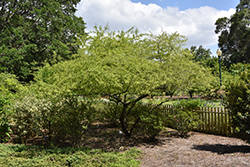Fri & Sat 8am - 8pm
Sun 8am - 7pm
Anytown, USA 12345
fax: 261.787.0463
e-mail: info@successgc.com


Plant Finder

Height: 20 feet
Spread: 15 feet
Sunlight:
![]()
![]()
Hardiness Zone: 8a
Other Names: Hog Plum, Sloe Plum
Description:
This small tree is smothered in showy white flowers in early spring followed by edible, tart purple fruit in summer; has a short, thickened trunk and a dense, flat-topped crown; will easily form a thicket if not maintained; full sun and well-drained soil
Ornamental Features
Flatwoods Plum is clothed in stunning clusters of fragrant white flowers with creamy white overtones along the branches from late winter to early spring before the leaves. It has dark green deciduous foliage. The pointy leaves turn yellow in fall. The fruits are showy deep purple drupes which fade to black over time, which are displayed in late summer. The fruit can be messy if allowed to drop on the lawn or walkways, and may require occasional clean-up. The rough dark brown bark adds an interesting dimension to the landscape.
This plant is primarily grown as an ornamental, but it's also valued for its edible qualities. The round tart fruit is most often used in the following ways:
- Cooking
- Baking
- Preserves
- Sauces
Landscape Attributes
Flatwoods Plum is a deciduous tree with an upright spreading habit of growth. Its average texture blends into the landscape, but can be balanced by one or two finer or coarser trees or shrubs for an effective composition.
This tree will require occasional maintenance and upkeep, and should only be pruned in summer after the leaves have fully developed, as it may 'bleed' sap if pruned in late winter or early spring. It is a good choice for attracting birds and squirrels to your yard. Gardeners should be aware of the following characteristic(s) that may warrant special consideration;
- Disease
Flatwoods Plum is recommended for the following landscape applications;
- Accent
- Orchard/Edible Landscaping
Planting & Growing
Flatwoods Plum will grow to be about 20 feet tall at maturity, with a spread of 15 feet. It has a low canopy with a typical clearance of 2 feet from the ground, and is suitable for planting under power lines. It grows at a medium rate, and under ideal conditions can be expected to live for 40 years or more. While it is considered to be somewhat self-pollinating, it tends to set heavier quantities of fruit with a different variety of the same species growing nearby.
This tree does best in full sun to partial shade. It is very adaptable to both dry and moist growing conditions, but will not tolerate any standing water. It is considered to be drought-tolerant, and thus makes an ideal choice for xeriscaping or the moisture-conserving landscape. This plant will benefit from an application of bonemeal and/or mycorrhizal fertilizer at the time of planting. It is not particular as to soil type or pH. It is highly tolerant of urban pollution and will even thrive in inner city environments. This species is native to parts of North America.
